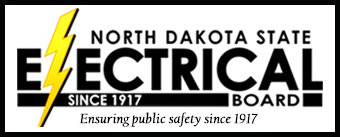North Dakota State Electrical Board - Laws & Rules
Laws, Rules and Wiring Standards
2023 Laws, Rules and Wiring Standards Effective 7/1/2024
*****************************************************************************************************************************************
2020 Laws, Rules and Wiring Standards Effective 10/1/2020*
- *Errata Sheet - To Be Used to Amend Sections of the 2020 Laws & Rules.
*NFPA 70 2017 edition National Electrical Code and NFPA 101 2015 edition Life Safety Code® through December 31, 2020 and NFPA 70 2020 edition National Electrical Code and NFPA 101 2018 edition Life Safety Code® thereafter.
*****************************************************************************************************************************************
2029 Administrative Rule Proposal Form Deadline 2/29/28
The purpose of these standards is the practical safeguarding of persons and of buildings and building contents from electrical hazards arising from the use or control of electricity for light, heat, power and control thereof, fire detection systems, and power limited systems. It covers the electrical and power limited installations and associated equipment necessary for its safe operation.
These standards, based on the National Electrical Code, are the result of years of experience and research to meet the demand for uniform standards to govern electrical and power limited systems wiring in North Dakota, and provide basic rules for intelligent and uniform installation and inspection.
All requirements contained herein shall be given careful consideration to ensure greatest permanence, convenience, and safety. These standards do not constitute a design specification for any particular installation, nor an instruction manual for untrained individuals. Skill and experience are necessary factors for a safe and adequate wiring installation. Whenever these requirements differ or are in conflict with the requirements of the NFPA 70 2023 edition, National Electrical Code (first version, printed in 2022) and NFPA 101 2021 edition Life Safety Code and applicable articles in locally adopted codes or North Dakota State Building Code pertaining to fire detection, fire alarms, fire communications, and smoke detectors, the more restrictive requirements are the minimum.

